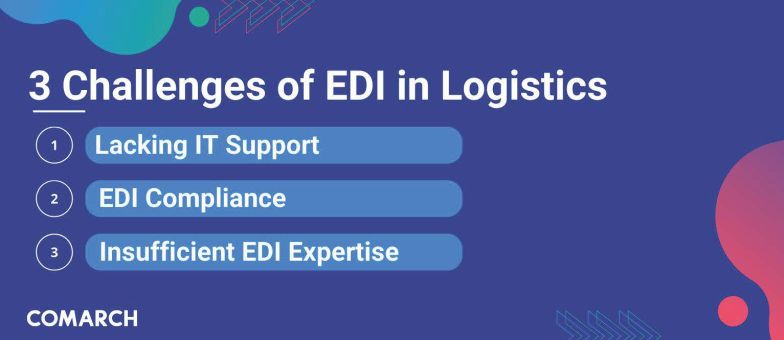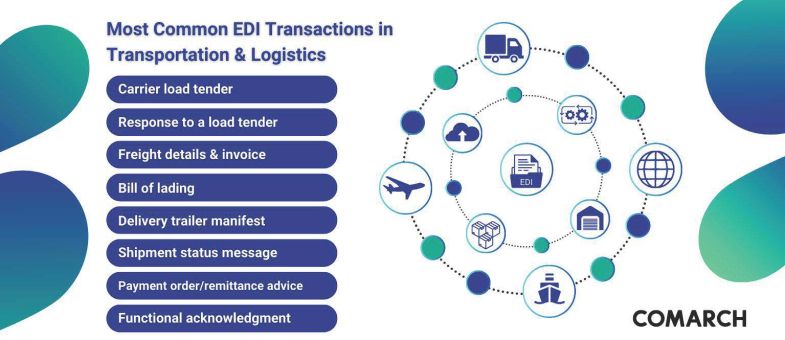How EDI in Logistics Improves Transportation Processes
Businesses with a well-structured and sustainable logistics strategy can achieve a multitude of impressive results. However, even the best strategy won’t be implemented successfully without effective and fast data flow. There are several ways to build a reliable, fast and transparent process. One of them is by using electronic data interchange. How can this be done, and why is it so important for this industry? Let’s find out.
What is Electronic Data Interchange (EDI) in the Logistics Industry?
Electronic Data Interchange, most commonly referred to as EDI, is a standardized electronic format designed to improve communication between organizations and limit human error. Logistics has long been plagued by the limitations of manual data extraction, recording, transmission, and logging. This was a time-consuming and error-prone methodology that caused far more harm than good for logistics providers, trading partners, and supply chain professionals.
The Importance of EDI for Transportation Companies
Transportation companies like carriers, brokers, and shippers are constantly looking for ways to improve efficiency and reduce costs. Many organizations in with dealings in the logistics industry are already using EDI to optimize processes and improve communication with clients and various business partners. All the while, making it easier to add new partners to their EDI platform and receive EDI freight offers. Over the years, it has been crucial for logistics companies to focus on a strong and efficient EDI strategy.
The transportation industry and logistics industry are two of the most crucial sectors of the world economy. However, these major industries illustrate a major challenge in terms of competitiveness. As an industry that demands rapid, accurate and efficient data and shipments, transportation was one of the first to adopt EDI software.
The use of EDI is crucial to building and maintaining long-term business relationships with customers and suppliers, ensuring efficient automation of daily communications on a large scale. By allowing departments to focus their attention on more important and profitable tasks, and eliminating the manual input of information into operational invoicing and shipping systems, EDI not only minimizes manual data entry but also saves time and money. As a result, it enables seamless, efficient communication between businesses.
An EDI solution brings organizations the full control and visibility they need to conduct business with customers and trading partners by automating and standardizing critical data exchange. By offering real-time processing of EDI data regarding inbound and outbound shipments, transportation companies, logistics providers, and trading partners will eliminate the hassle that is often associated with transport operations, while making workflows smoother and more efficient.
How Does EDI Work in Logistics?
EDI plays an integral role in logistics, helping companies manage a wide range of crucial processes. For decades, logistics organizations have relied on EDI for functions such as:
- Communicating with customers
- Onboarding new trading partners
- Receiving an EDI load tender
- Business communication automation
While EDI has been around since the 60s, it remains a staple in many supply chain titan's software ecosystems, including UPS and FedEx. So, how has EDI withstood the test of time? Well, modern EDI integration allows for extended data flows that broaden a company's presence while maximizing efficiencies.
3 Challenges of EDI Solutions in Logistics

Although EDI has been around for decades, there are still some challenges to overcome. Let's explore three of the most common hurdles companies face in regard to EDI adoption and migration.
For companies within the shipping and logistics industry that navigate a wide range of supply chain partners, business documents, and standardized electronic formats -- these issues can be exponentiated. Let's take a closer look:
1. Lacking IT Support
Perhaps the most significant challenge for companies looking to adopt or migrate EDI is a lack of in-house resources. Depending on the size of the organization (or its focus), it's not uncommon for companies to have a deficiency in the IT or EDI department.
2. EDI Compliance
For companies within the shipping and logistics industry that navigate a wide range of supply chain partners, business documents, and standardized electronic formats -- these issues can be exponentiated. Compliance regarding EDI communication helps ensure a positive relationship with trading partners while also protecting organizations from chargebacks, penalties, and fines.
3. Insufficient EDI Expertise
Piggybacking off insufficient IT support is the lack of specific expertise with EDI capabilities. Proficiency in EDI communication and compliance plays a significant role in the EDI shipping process. This is why so many logistics companies, transportation organizations, and even trading partners rely on outsourcing their EDI to dedicated providers.
The Most Relevant EDI Transactions in Logistics

With the use of EDI, it is possible not only to exchange standard documents such as orders and invoices, but also to get many industry-specific transactions done simply.
The most relevant EDI transactions used in logistics to communicate between carrier, shipper, and consignee using electronic documents include:
- Carrier load tender: Commonly submitted by the sender/shipper to the carrier to ask for the pick-up of the shipment.
- Response to a load tender: Used by a carrier in reply to the carrier load tender message to accept or reject the collection of a shipment.
- Freight details and invoice: Issued by the carrier to the sender/shipper after completion of delivery, it contains full shipment details and is used as a payment request invoice.
- Bill of lading: An electronic document issued by a carrier to a sender/shipper, including shipment details such as quantity, date, shipper, consignee, and destination of goods being carried.
- Delivery trailer manifest: Issued by a carrier to the consignees to notify them about the contents of a multi-cargo trailer.
- Shipment status message: A typical delivery status message sent by the carrier to the shipper and/or to the consignee to update on the status of a shipment/delivery.
- Payment order/remittance advice: Used to process a payment to a payee or as remittance advice, indicating the details required to apply the payment to the payee's credit system.
- Functional acknowledgment: Used by shipper and carrier in response and confirmation to each received message.
There are many other EDI transactions used in the transportation industry, including sets for air, sea, rail and road transport, but it is possible to adapt your EDI solution according to your preferences or specifications of a certain system. That is because electronic data exchange software is fully customizable.
Nowadays, in conducting business and communicating with business partners where the need to prepare, send, receive and process a large number of documents is significant, EDI technology is very common in many countries. It is used by small businesses and large corporations.
There are different common EDI standards used in transport and logistics worldwide, such as:
- EDIFACT: used principally in Europe and in international transport
- ANSI X12: the main standard used in North America
Both of them are designed to exchange documents electronically and perform business processes between business partners.
Benefits of EDI For Transportation Companies
The use of EDI is becoming increasingly common in logistics globally, as it can transform businesses from complex and unmanageable entities to streamlined and more efficient operations. It also has many other advantages which make it so highly desired in the industry.
The exchange of EDI documents between trading partners greatly streamlines and simplifies business processes. For this reason, in logistics (independent of the mode of transport) EDI is now being used as a fast, cost-effective and secure way of transmitting relevant business information relating to freight transport (movement of goods).
The key benefit for those working in transport is that core business communications, especially when considering high volumes of exchanged information, can be automated with the use of EDI. This allows forwarders and accounting teams to spend more time focusing on more productive tasks and delivering better customer service to their clients.
EDI also eliminates the need for shippers/forwarders to enter information manually into their accounting and operational shipping systems. This saves time and money by eliminating any potentially costly data entry errors that may occur.
Other important benefits include:
- Increased speed and accuracy for communicating smoothly and efficiently with all parts of the supply chain
- Possibility to reduce manual intervention and human error
- Elimination of paper and all the expenses it entails
- Streamlining the entire supply chain, including transport management, planning and monitoring processes
- Improving the effectiveness of logistics and procurement, and optimizing inventory/warehouse management
- Secure, private networks for data exchange
What Does the Future Hold for EDI in Logistics and Transportation?
The discussion surrounding the future of EDI is fraught with contention. While some believe that EDI is outdated, the truth is EDI has done wonders for the transportation, shipping and logistics industries. While initial benefits were communication improvements and cutting down on manual data entry, automation capabilities and extended data flows have allowed EDI to become far more than a document processing solution.
So, what's next? Well, it's all about the broader want for APIs and web services. APIs allow for direct communication between applications and web services allow for cohesion throughout a network. However, these future-forward approaches have some significant issues.
- A lack of standardization
- Not enough compatibility with legacy operations and systems
- APIs and web services aren't built for the supply chain
These solutions will need to integrate with existing EDI infrastructure to make any real headway at the enterprise level. Additionally, and perhaps most importantly, adopting API and web services without proper expertise can congest processes and lead to unnecessary complications that can cost time and money to overcome.
Wrap-Up: Logistics Providers and Transportation Companies Function Still Need EDI
There are many reasons why transport and logistics companies might be interested in electronic data transmission with the use of EDI software.
Each individual EDI system may have different functions involving partly different technical solutions and organizational configurations. Such systems are cost-effective when they can be used for high numbers of regular, repeated and standardized transactions, and thus within closed agreements and long-term inter-organizational relationships.
Implementing an EDI solution enables transport and logistics businesses to increase resource efficiency, gain full control of costs, and become more efficient and competitive in the marketplace. If you need help choosing the right EDI provider, we’ve got a guide for that.
So yes, it is possible to function without EDI – but why not make things easier and more efficient?



